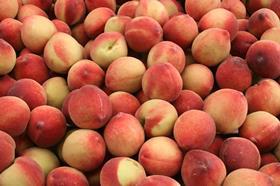
France is expected to produce four per cent more peaches and nectarines this year than it did in 2016, according to crop estimates from Europech.
The improved forecast, announced at medFEL on 26 April in Perpigan, is due in part to favourable weather conditions and good flowering and pollination at the beginning of the 2017 season.
French volumes are expected to rise from 202,198 tonnes in 2016 to 209,284t this year, with all of France’s top three production areas – Launguedoc-Rousillon, Provence-Alpes-Côte d'Azur and Rhne-Alpes – set to enjoy minor increases.
The forecast remains 15 per cent lower than the five-year average from 2011 to 2015, but early, abundant and well-grouped flowering at the start of this season looks set to boost volumes slightly.
Additional forecasts are normally announced at medFEL for Europe’s other three main producing nations – Italy, Spain and Greece – but this year these countries judged it too early to deliver accurate crop estimates so early in the season. Instead they will wait until 18 May in Montpellier.
France has experienced a cold winter this year, particularly in January and February, causing early flowering around mid-March.
Bruno Darnaud, president of association of producer organisations for French peaches and apricots, was upbeat about the fact flowering had started ten days earlier than in 2016, but he reported that French orchards were hit by frosts on 20 and 21 April.
The stone fruit sector should not rule out the possibility of further weather problems, he added, pointing to the damage caused by hailstorms in France last year.
According to Eric Hostalnou from the Pyrnes-Orientales Chamber of Agriculture, the 2016 season was marked by a relatively mild winter without any major weather problems, prompting crop forecasts close to past averages. However, from May onwards several adverse growing conditions affected production, particularly in the Rhône valley.
The start of the 2016 campaign was tight, with lots of Spanish peaches and nectarines on supermarket shelves and weather that reduced eating quality in June, but the summer brought high temperatures, good fruit quality, steady volumes and stable prices, Hostalnou reported.
“In the end the 2016 campaign for peaches and nectarines was satisfactory,” he said.
Looking further afield, Darnaud said Spanish and Italian stone fruit producers are suffering from the fact that they are competing for the same markets, with the Russian import ban continuing to limit consumption.
He believes the French market will benefit if it continues to prioritise French products despite strong pressure from Spanish and Italian producers, but he acknowledged that France has lost a large part of its export markets for peaches and nectarines.
In apricots, meanwhile, total European production is set to rise 17 per cent compared to 2016 - a 10 per cent increase on the 2011-2015 average.
Greece is expected to see the biggest rises, with volumes up 41 per cent on 2016; Spanish production will drop 17 per cent, but remain 13 per cent above the 2011-2015 average; Italy can expect 20 per cent higher volumes; and France production is set to rise by 39 per cent, following a bad season in 2016. The French forecast remains six per cent lower than the 2011-2015 average however.



